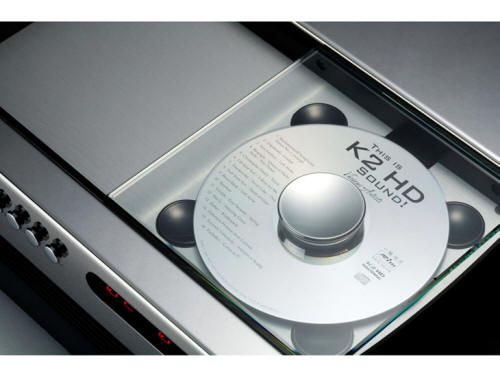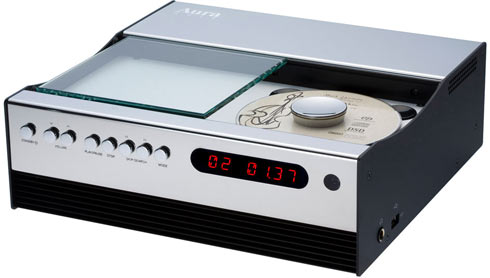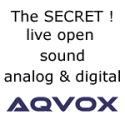
You are reading the older HTML site
Positive Feedback ISSUE
41january/february 2009
april music
Aura Note Music Center
as reviewed by Victor Chavira

|
Back in Issue 40, Dean Seislove wrote an informative article about the Aura Note Music Center. Since our editor Dave Clark knew I was interested in listening to USB DAC type components, he suggested that I follow up on Dean's article. To be quite frank, the first thing that came to mind when considering the Aura Note Music system was the retro Crosley CD, LP, radio, cassette player music consoles that are often advertised in junk mail or in the back pages of magazines aimed at an older demographic. In all fairness, I'm sure the Crosley consoles sound quite fine. However, we are a audiophile driven webzine with lofty standards for good sound. Would the Swiss army knife Aura Note Music Center stand up to my esteemed Magnum Dynalab MD208 receiver? Read on.
Think of the Aura Note Music Center (Audio Note Music Center) as a 50-watt integrated with added features. The Audio Note Music Center is about half the size of my MD208 but felt like a dense 20lb. weight in my hands. The rear of the Audio Note Music Center has one pair of RCA inputs, a USB port, and knurled knob binding posts for speaker cables. The right side has an additional USB slot for MP3 music players or flash drives and 1/4 inch output for headphones. The chrome front of the unit has a row of buttons and red alphanumeric display that flashes "WELCOME" and "GOODBYE" upon start up and shut down. Time is shown by the display like a clock radio when the unit's musical functions are not in use. The tiny lettering under each button is nearly impossible to read against the chrome fascia. This makes keeping track of the credit card sized remote very important for adjusting the volume or muting in case of a phone call.
The illustrated manual shows a DVD player linked to the lone set of RCA inputs but I connected my E.A.R. 834P phono preamp. My Apple Mac Mini serves as my DVD player and primary source for music which I will describe later in this follow up. Because I wanted to check one item off the list, I listened first to the FM tuner. Of course, Magnum Dynalab is recognized as a leader in tuner technology. Nevertheless, the little chrome unit produced admirable sound from my favorite stations. Unlike the MD208, the Audio Note Music Center allows the user to scan and program stations via remote rather than turning a dial. I was impressed by the very low levels of noise and excellent stereo separation. Music sounded detailed and direct, scarcely hinting that the source was being transmitted from miles away through the atmosphere. By comparison, the MD 208 painted tonal colors with deeper pigments an bolder strokes of the brush. Voices and instruments resonated with harmonic richness and warmth on the classical station. By the same token, compressed signals and the boosted bass of rock DJs and Hip Hop stations were also unmercifully exposed.

Next I listened to the CD player. The CD player seemed like an afterthought that was grafted on the top of unit to offer additional value. However, the CD performance was actually quite good. Without the residual effects of interconnects, music sounded dynamic and uncolored. I dug out some favorite CDs and wasn't disappointed when played them back on the Audio Note Music Center. To play a CD, slide the unsecured glass square across the top and remove the magnetic puck. Then insert CD on the spindle and replace the puck. I caution listeners with long nails to be careful during this process as the exposed laser lens might suffer damage from errant finger. The laser and mechanism are also susceptible to contamination from house dust so periodic cleaning is a must. Overall, the performance of the CD player was on par with the sound of my Phillips SACD/DVD player.
The Music Center's stellar feature, however, was its internal USB DAC. Returning to my Mac Mini, I used the Audio MIDI Setup utility program to set the Aura Note as the default output. This process allowed the Audio Note Music Center to decode my iTunes playlists and stereo audio output from DVDs. My usual arrangement for listening to iTunes playlists links the analogue output of my computer to the MD208 receiver with a 1/8th to RCA Monster Cable interconnect. The computer's default internal DAC is pleasing enough for casual listening. The Audio Note Music Center USB DAC, though, elevates listening to iTunes playlists or viewing DVDs to highly musical and stimulating experience. The difference in sound between the straight analogue outputs versus the Audio Note Music Center USB DAC is like listening to high efficiency speakers for the first time. All of a sudden, the listener is captivated by fine musical details and clues in a recording or performance that were previously lost in translation. For example, one evening my family gathered around our 37" HDTV to view The Express DVD about the brief life of college football phenom Ernie Davis. I was completely enthralled by the punishing sounds of helmets and shoulder pads crashing violently together during the action packed football scenes. The heroic soundtrack added perfectly to the emotional impact of the story on the screen. At one point, a solitary snare playing a delicate drum-roll sounded as if it came from about tweenty feet behind the TV. The sound image was unambiguously clear as were other sound effects and dialogue.
 The Music Center's USB DAC continued to
impress while listening to Apple Lossless rips of my partial CD
collection. All of my iTunes playlists benefited from the USB DACs
superior resolution and sonic accuracy. For example, the song
"Contemplation" from McCoy Tyner's latest CD Guitars sounded vibrant and
spacious. Each instrument, guitar, piano, bass, and drums retained its
unique and realistic identity on the deep soundstage. Listening to the
same track directly from the CD player presented a very slightly
diminished soundstage and minute degree of softening around the edges of
fine details. This characteristic was observed repeatedly with all the
music I listened to from Mozart's Ave Verum Corpus, K618 to Miles Davis
Legacy Edition CD of A Kind of Blue. On K18, the different sections of
the orchestra and choir were clearly rendered on an extensive soundstage
with the USB DAC. Likewise, I could easily follow Jimmy Cobb's rhythmic
brush and stick work on A Kind of Blue. The images and harmony between Coltrane
and Cannonball on All Blues were vividly authentic. Of course, of all
the sources available to me, LP is still the preferred method for
ultimate musical gratification. I most enjoy listening Tito Puente's On
Broadway recording on LP, followed by iTunes with the Audio Note
Music Center USB DAC, then
the CD version.
The Music Center's USB DAC continued to
impress while listening to Apple Lossless rips of my partial CD
collection. All of my iTunes playlists benefited from the USB DACs
superior resolution and sonic accuracy. For example, the song
"Contemplation" from McCoy Tyner's latest CD Guitars sounded vibrant and
spacious. Each instrument, guitar, piano, bass, and drums retained its
unique and realistic identity on the deep soundstage. Listening to the
same track directly from the CD player presented a very slightly
diminished soundstage and minute degree of softening around the edges of
fine details. This characteristic was observed repeatedly with all the
music I listened to from Mozart's Ave Verum Corpus, K618 to Miles Davis
Legacy Edition CD of A Kind of Blue. On K18, the different sections of
the orchestra and choir were clearly rendered on an extensive soundstage
with the USB DAC. Likewise, I could easily follow Jimmy Cobb's rhythmic
brush and stick work on A Kind of Blue. The images and harmony between Coltrane
and Cannonball on All Blues were vividly authentic. Of course, of all
the sources available to me, LP is still the preferred method for
ultimate musical gratification. I most enjoy listening Tito Puente's On
Broadway recording on LP, followed by iTunes with the Audio Note
Music Center USB DAC, then
the CD version.
Taken as a 50 watt integrated, the Audio Note Music Center is worth the price of admission. This mirror faced machine is engineered in the spirit of solidly built British integrateds like Naim, Rega, and Arcam. No wonder given that the unit was designed by UK industrial designer Kenneth Grange. The Music Center's 50-watts are rather robust. I never lacked for power or managed to make the unit clip. I listen to music at mostly moderate levels thereby giving the power plenty of headroom for dynamic peaks. For example, a good test of bass dynamics is "Moun Badinina" by Mino Cinelu. This iTunes song features six-string bassist Richard Bona playing notes way down low. Search his name on You Tube to view this talented musician. The song turned out firm low dynamic pulses of energy that rattled the picture frames on my walls. Your performance may vary depending the power requirements and abilities of your speakers. Needless to say, my Marten Miles II speakers responded wonderfully.
All in all, I was very impressed with the Aura Note Music Center. I enjoyed every aspect of its performance. The USB DAC completely transformed my iTunes listening experience from average to extraordinary. My feeling is that most prospective buyers will likely connect their computers to the unit and ignore the top mounted CD player. Interestingly, connecting my son's iPod Nano to the side USB port produced no sound. However, when I copied Pat Metheny and Ruben Gonzalez MP3 files to a thumb drive and inserted it into the side port, the song titles scrolled on the display and could be played back like a CD. With the proliferation of computer based music playback on the rise, more components will feature USB support. The Aura Note Music Center is a stellar example. Victor Chavira
Aura Note
Retail: $2350
April Music
web address:
www.aprilmusic.com

